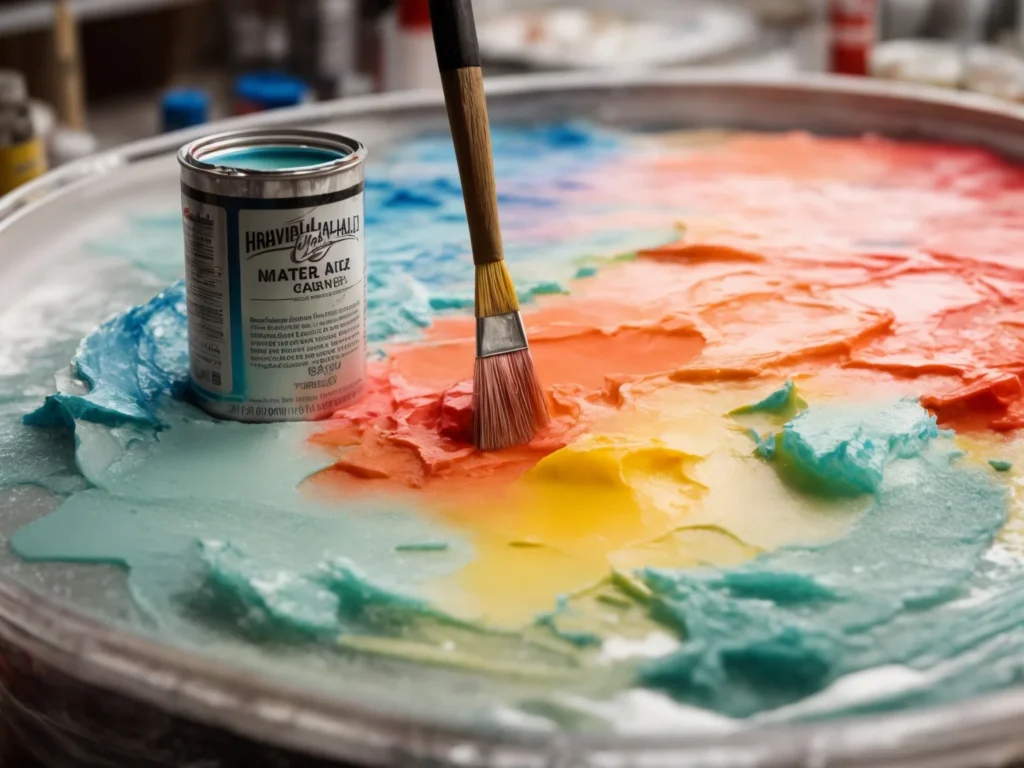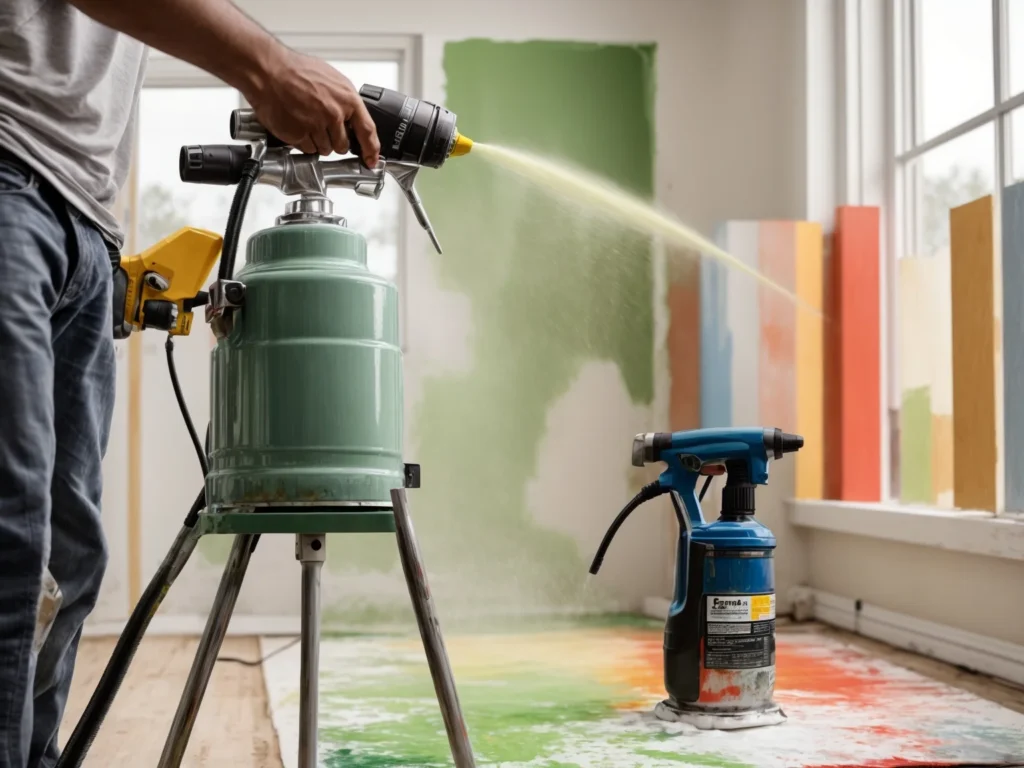Acrylic paint has become one of the most popular mediums for artists and hobby painters alike. Known for its fast drying time, versatility, and easy cleanup with water, acrylics are a staple in most art studios and classrooms. But what happens if acrylic paint is exposed to freezing temperatures? Can acrylic paint actually freeze? And will freezing ruin or damage acrylic paint?

In this comprehensive guide, we’ll explore the science behind acrylic paint, look at temperature thresholds, compare acrylics to oil paints, and provide practical tips for using, storing, and shipping acrylic paint in cold weather conditions. With the right information and preventative steps, acrylic painters can continue creating in colder climates while avoiding potential freezing issues.
An Introduction to Acrylic Paint Composition
Before examining how temperature impacts acrylic paint, it’s helpful to understand what exactly makes up acrylic paint in the first place.
Acrylic paint contains pigment particles suspended in an acrylic polymer emulsion. The pigment provides color, while the acrylic emulsion acts as the binding agent that allows the pigment to adhere to surfaces. Some key components in acrylic paint’s emulsion binder include:
- Acrylic polymers – Acrylic polymers are plastic-based compounds that form a flexible film when dried. Polymers provide acrylic paint with durability and resistance.
- Surfactants – Surfactants allow acrylic polymers to dissolve in water and help improve the flow of wet paint. They also contribute to the smooth consistency of acrylics.
- Thickeners – Thickeners give acrylic paint its viscosity and texture. They prevent pigments from settling and separating.
- Biocides – Biocides are added to inhibit bacteria, mold, and mildew growth within the damp emulsion. This helps increase acrylic paint’s shelf life.
Understanding this chemical makeup provides insights into how temperature fluctuations can impact the stability and integrity of acrylic paint. The polymer binder in particular reacts to freezing conditions.
How Does Freezing Affect Acrylic Paint Chemistry?
When acrylic paint is exposed to freezing temperatures, both the pigment and binder can be altered. Here are some of the potential effects:
- Binder solidification – Below freezing, acrylic polymers and emulsion may harden or become brittle. This can inhibit their ability to properly bind pigments.
- Pigment separation – Freezing can cause pigment particles to separate from binders. Dense pigments may sink while lighter ones rise, resulting in color inconsistencies.
- Film disruption – Already dried acrylic paint films become more inflexible in freezing temperatures. This leads to cracking or flaking.
- Additive disturbance – Freezing alters the intended properties of surfactants, thickeners, and biocides which help stabilize wet paint.
Overall, the freezing and partial solidification of acrylic paint’s liquid components is the primary concern. Let’s look at specific temperature guidelines for acrylics.
What Are the Ideal Temperature Ranges for Acrylic Paint?
Acrylic paint performs optimally within certain temperature ranges, generally between 60-75°F or 15-24°C. This room temperature range allows binders and pigments to flow and interact properly when wet. It also enables stable drying and curing of acrylic films.
More important are the minimum temperature thresholds that should be avoided:
- Wet paint – Acrylics may freeze around 45°F (7°C) or below. Freezing wet paint can permanently alter the consistency and binding capacity.
- Dried paint film – Cracking can occur below 32°F (0°C) as films become brittle. Long-term freezing ruins flexibility.
Storing acrylics in conditions that dip below these minimum temperatures runs the risk of freeze damage. But how do acrylics compare to oils in cold weather?
Acrylic Paint vs. Oil Paint in Freezing Conditions
Many artists opt for oil paints in cold studio spaces or outdoor painting conditions thanks to their resiliency against freezing. Here’s how oil paints differ from acrylics:
- Oil binding agent – The drying oils used in oil paints remain flexible when cold. Acrylic polymers become stiff and brittle below 45°F (7°C).
- Moisture content – Oil paints contain little moisture that could freeze and expand. But acrylic emulsions contain a high water content.
- Drying time – The slow drying of oils allows paint to remain workable even if partially frozen. Quick-drying acrylics become unusable once frozen.
The bottom line is oil paint can withstand complete freezing with little permanent damage. Acrylics, however, are much more vulnerable to freezing’s destabilizing effects. Let’s look at some acrylic storage tips for artists dealing with cold conditions.
Storing Acrylic Paint in Cold Climates
What steps should acrylic painters take to properly store paints in environments prone to cold temperatures? Here are some best practices:
- Keep acrylics indoors whenever possible. Unheated spaces like garages, sheds, or vehicles can expose paint to freezing.
- Avoid direct contact with cold external walls which may drop below 45°F (7°C). Store paints in an insulated, interior closet.
- For outdoor painting in winter, keep paints in an insulated, portable cooler or bag. Pack with blanket insulation.
- During home storage, maintain room temperatures above 45°F through thermostat adjustments and space heater use if needed.
- For periods of sub-freezing weather, consider storing paint indoors at room temperature to be safe.
With vigilance and some added insulation, artists can continue using acrylics even in cold studio or storage spaces. But what about transporting paints?
Shipping and Traveling With Acrylic Paint in Cold Conditions
Transporting acrylic paint in freezing temperatures requires additional precautions. Here are tips for keeping acrylics from freezing during shipping or travel:
- When shipping paint, use insulated packaging like foam cooler boxes. Include heat packs. Alert shippers to keep refrigerated.
- For air travel, carry paints in hand luggage where possible to avoid cargo holds with extreme cold. Insulate in bags.
- During ground travel, keep paint away from vehicle exteriors. Acrylics left in unheated trunks or truck beds may freeze.
- Pack acrylics in insulated cooler bags when traveling. Surround individual tubes or jars with bubble wrap.
- After exposure to cold, allow paints to gradually warm to room temperature before use to avoid moisture condensation.
With preparation, acrylic painters can transport paints safely despite freezing conditions. But what if paint freezes despite best efforts?
Dealing With Frozen Acrylic Paint
In the event acrylic paint does accidentally freeze, here are some steps to take:
- Allow the frozen acrylic to slowly thaw at room temperature. Never rapidly heat frozen paint.
- Once thawed, inspect consistency and test application. Discard if severely thickened, separated, or becomes gummy.
- For paint showing minimal changes, attempt to remix gently with a palette knife. But monitor closely when applying to avoid poor adhesion.
- Never re-freeze paint after thawing, even if it seems normal. The freeze/thaw cycle permanently damages acrylics.
- Dispose of paint properly if freeze damage is evident. Dry acrylic can be discarded normally. Wet paint requires hazardous waste guidelines.
While thawed acrylic may appear usable after freezing, it’s always best to discard any paint that drops below 45°F (7°C) to avoid ruining artwork down the line. Now let’s look at whether certain acrylic brands hold up better than others against the cold.
How Acrylic Paint Brand Impacts Freezing Resilience
When exploring the freezing points for acrylics, individual paint brands and lines demonstrate differences:
- Student vs. professional – Student acrylics with more fillers and lower pigment levels tend to be slightly more vulnerable to freezing damage. Professional grades offer more stability.
- Heavy body vs. liquid – Heavy body acrylics are thicker and less prone to component separation when frozen. Liquid acrylics are more likely to demonstrate freezing damage.
- Open vs. squeezable – Tube acrylic paint is exposed each time used, increasing moisture exposure. Squeezable bottle acrylics have lower freeze risk.
- House paint brands – Budget exterior house paint acrylics rely on freeze/thaw stability and offer beginner painters reliability.
Consulting specific brand guidelines provides insights into ideal temperature ranges. But in general, professional acrylic lines offer greater freeze protection over student grades. Next let’s recap key tips.
Key Considerations for Acrylic Paint in Cold Conditions
Freezing temperatures create risks for acrylic paints that oil-based paints do not face. By understanding acrylics’ vulnerabilities and taking preventative steps, artists can maintain the quality and stability of their paints even in cold conditions.
Here are some key tips to remember:
- Avoid sub-45°F storage – Wet acrylic paint can begin freezing at 45°F (7°C). Make sure all storage spaces stay above this threshold.
- Insulate whenever traveling – Transport paints in insulated bags or wrappings to prevent freezing en route. Include warm packs if needed.
- Keep paint moving in use – If painting outdoors in cold weather, keep acrylics close to body to retain warmth and frequently remix paints on palette to maintain binder elasticity.
- Rewarm gradually if exposed – After any potential freezing, have paint slowly warm back to room temperature before opening to prevent condensation issues.
- Discard if frozen – Do not attempt to salvage frozen acrylics. Always dispose of paints that drop below 45°F (7°C) to avoid bonding and curing issues.
- Follow all manufacturer guidelines – Check brand specs for their recommended cold temperature use limits and ideal storage conditions.
By being vigilant against freezing and following usage best practices, acrylic painters can feel confident working in cold conditions while avoiding the perils of frozen paint.
Frequently Asked Questions
Does acrylic paint get ruined in the cold?
Yes, acrylic paint can be permanently ruined if frozen. The polymers and binders are vulnerable to damage at temperatures below 45°F (7°C) which will irreversibly alter paint viscosity, consistency and adhesion.
Will acrylic paint break if frozen?
Freezing can cause both wet and dry acrylic paint films to crack, flake or become brittle. The freezing and expansion of water in the emulsion causes paint to expand and contract in ways that damage binder cohesion.
How cold is too cold for acrylic paint?
Acrylic paint should never be stored or used at temperatures below 45°F (7°C). Allowing paints to drop below the freezing point of water poses severe risks of permanent damage to acrylics. Take measures to prevent exposure.
Is acrylic paint OK if it freezes?
No, acrylic should always be discarded if known to have frozen. Even if thawed tubes or jars appear usable, the freeze/thaw process negatively impacts the chemistry and stability of acrylic paint in ways that will compromise artwork.
Can you revive acrylic paint after freezing?
It is not recommended to attempt to revive frozen acrylic paint. Thawing and remixing may seem to restore paint but the damage at a chemical level is irreversible. Discard any frozen acrylics to avoid ruining artwork after application.
Final Thoughts
With proper storage and handling precautions, artists can continue using versatile acrylic paints even in environments prone to sub-freezing temperatures. Being informed about acrylic limitations compared to oil paints allows painters to make modifications to their process and materials storage when confronted by winter weather. Remember to keep acrylics insulated, monitor conditions, and take quick action if paint becomes exposed to freezing. By following manufacturer guidelines and best practices, acrylic painters can embrace the cold weather while avoiding frozen paint predicaments.





